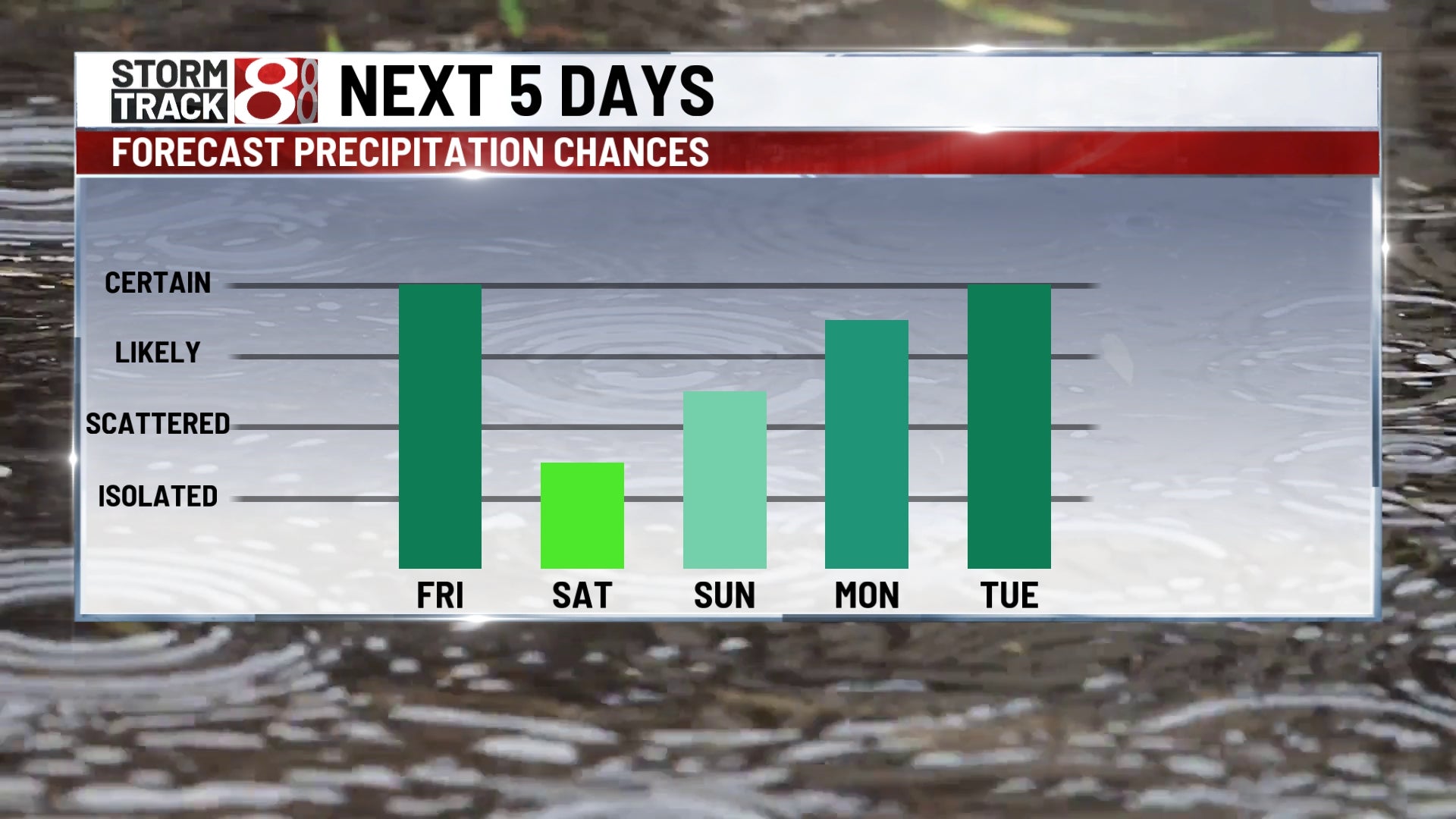Lifestyle
These bleating firefighters have an insatiable appetite for wildfire fuel — weeds

When it comes to wildfire control, you’ve gotta love goats.
Machines may be cheaper at clearing open spaces by tilling flammable weeds — and all their seeds — into the ground, but they’re also noisy and polluting, damaging soil structure and the beneficial bugs and organisms that dwell underground.
Goats, on the other hand, are relatively quiet — save the occasional bleating and bell tinkling — and can easily access steep hills and canyons that machines would not be able to manage, said Cris Sarabia, conservation director of the Palos Verdes Peninsula Land Conservancy.
Palos Verdes Peninsula Land Conservancy Conservation Director Cris Sarabia stands next to an electric fence on a hillside being cleared by goats in Rancho Palos Verdes.
(Brian van der Brug / Los Angeles Times)
They’re also voracious and highly efficient at eating almost every plant and seed in their path, leaving only a crunchy mulch of stripped stems and piles of natural fertilizer — poop — that enrich the soil, an important consideration when, like Sarabia, you’re in the business of habitat restoration.
Goats are just about the best when it comes to clearing large swaths of weeds on steep terrain, said Michael Choi, co-owner of the Mariposa-based herding company Fire Grazers Inc. Sheep are pickier eaters, he said, “and if you tried to put a cow in this canyon, it might start rolling down the hill. Goats are natural mountaineers.”
Plus, these nimble, four-footed firefighters are super adorable and fun to watch. “Some people say it’s therapeutic,” Choi said. “They take a break every day to come out and just stare at the goats to calm down. They are very restful creatures.”
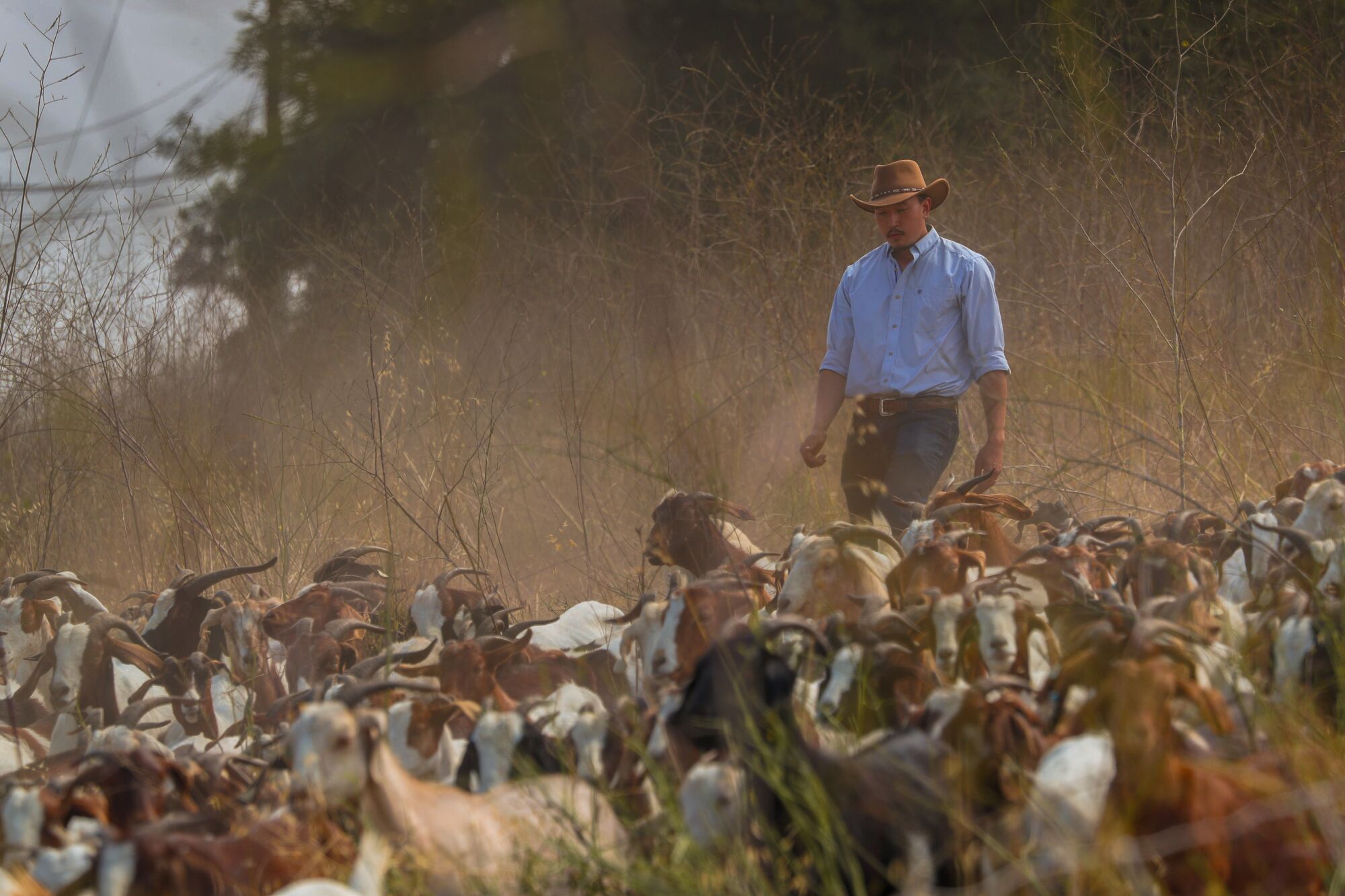
Goat herder Michael Choi of Fire Grazers Inc. moves a herd of 300 goats on a hillside below multimillion-dollar homes in Rancho Palos Verdes.
(Brian van der Brug / Los Angeles Times)
This day in early June we’re standing on a steep hill in Malaga Canyon, open space owned by the city of Rancho Palos Verdes that’s part of the Palos Verdes Nature Preserve. The city has hired Choi to clear the area of weeds, and he has two herds of about 300 goats each working at either end of the canyon, which is bordered by spacious homes.
The herd nearest us has only been grazing a day, and already it’s denuded half of the eastern canyon, which was thick with invasive wild radish and black mustard plants over 5 feet tall. Choi figures they’ll clear the entire canyon in less than four days.
Choi’s job isn’t relaxing. Before his brood can graze, he and his herders have to roll out soft-wired electric fences powered by batteries to keep the goats from wandering into nearby streets or yards. They have to make sure the goats have ample water, minerals and salts and keep moving those fences as the herd moves to new pastures.
Choi’s huge Anatolian shepherd dogs, Trinity and Buster, guard their herds from predators day and night. But these goats are escape artists who are always trying to find tastier pastures, Choi said, so he has to keep a sharp eye, dispatching his border collie, Bernie, to round up stragglers and adventurers.

Goat herder Michael Choi of Fire Grazers Inc.
(Brian van der Brug / Los Angeles Times)
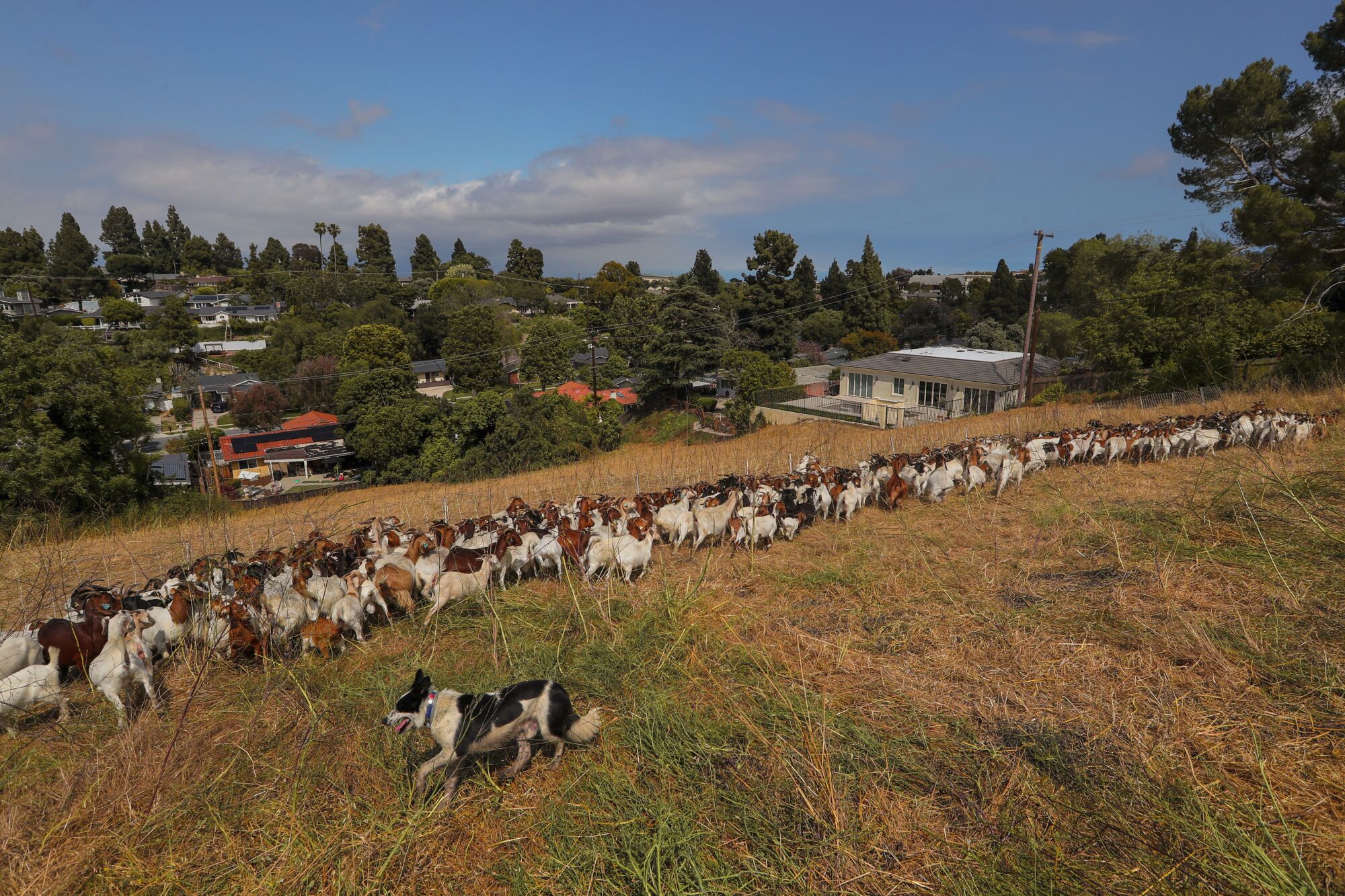
Michael Choi’s border collie, Bernie, herds goats on a hillside above a neighborhood in Rancho Palos Verdes.
(Brian van der Brug / Los Angeles Times)
Generally, the goats prefer to stick together in large groups, and feel vulnerable when they’re alone.
It might be doable to have a few roaming your property, he said, “but you’d need to commit [to watching them]. You can’t just let them out there and say, ‘Be free,’ because then they get into your neighbor’s yard and it’s a liability issue, which is my nightmare.”
His family-owned business requires a minimum of five acres at a cost of about $1,000 to $1,500 an acre to keep a herd busy. And that’s paying around $4,000 a month to his herders now. As more municipalities and organizations hire goats to help with fire suppression, a debate is heating up in Sacramento over state rule changes that would require goat herders to be paid at an hourly rate, plus overtime, versus the current minimum monthly wage. Choi says that would more than triple what he currently pays, and “would be the end of goat herding in California.” But labor advocates say goat herders, who are expected to manage herds 24/7, should get a bigger share of revenues.
On this sunny day, however, the goats are streaming down the hill to a new grazing area, egged on by the indefatigable herding dog Bernie. Choi holds down the soft electric fence so our group can get closer, shouting at Bernie to “Lay down!” so the goats will settle. Bernie immediately goes into a crouch, but even then he is pure energy, trembling as he waits for Choi’s next command.
Meanwhile, Sarabia scoops up a baby billy goat and cradles him in his arms. He’s unashamedly besotted by this sweet, tiny-horned creature. It’s a persuasive representative for the conservancy’s Adopt-a-Goat program, one of its many fundraising projects to support its work restoring habitat on the 1,400-acre Palos Verdes Nature Preserve to rebuild threatened species like the western monarch and Palos Verdes blue butterflies.
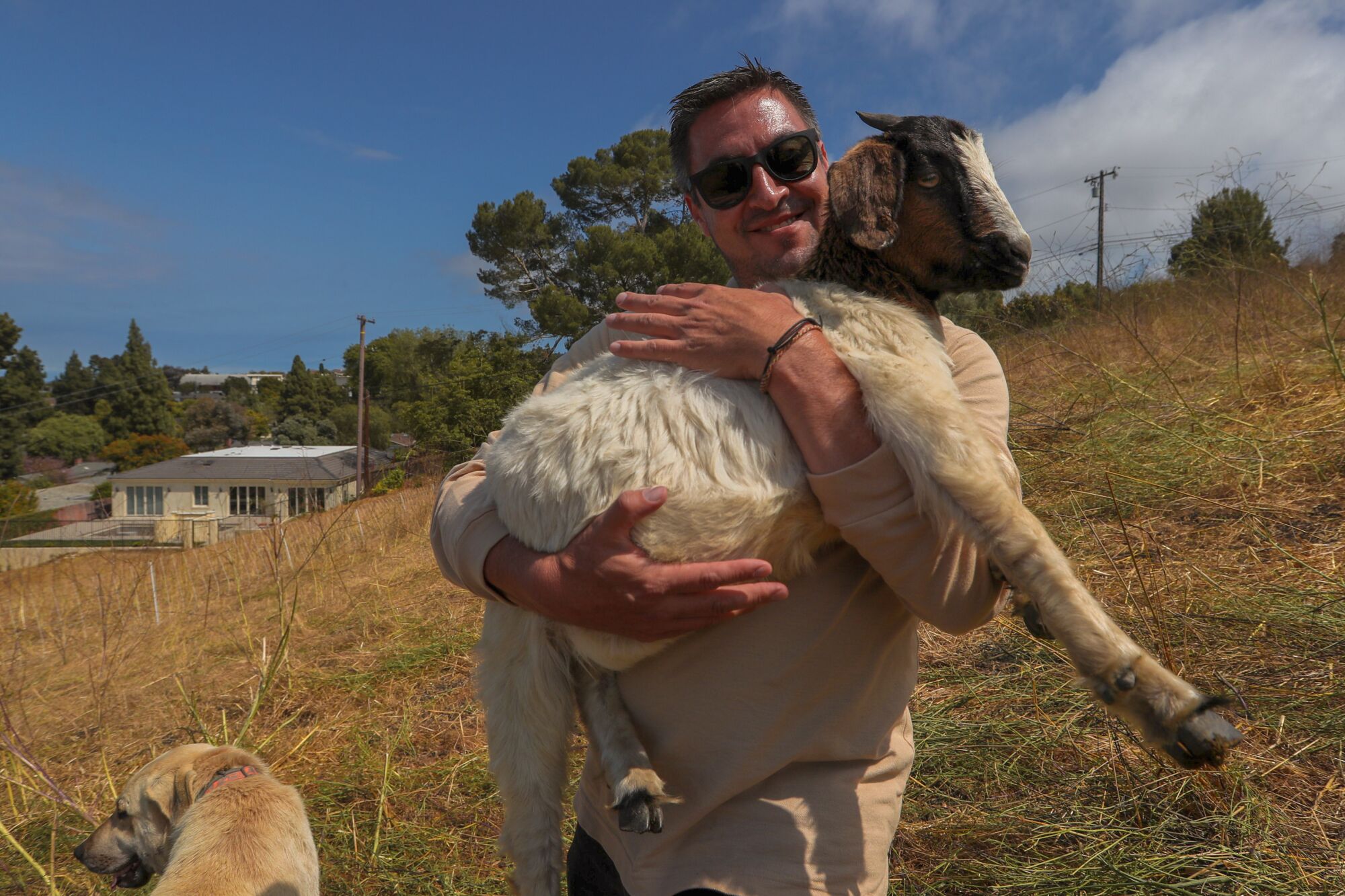
Palos Verdes Peninsula Land Conservancy Conservation Director Cris Sarabia holds one of goat herder Michael Choi’s goats.
(Brian van der Brug / Los Angeles Times)
The goats aren’t just clearing the land of weeds, Sarabia said. They’re also preparing certain parts of the preserve for habitat restoration projects later this year. The conservancy used grant money to clear more than 13 acres in Lunada Canyon, where it hopes to gather volunteers this fall to plant deerweed (Lotus scoparius) and other native plants to restore habitat in the canyon for threatened birds and pollinators.
These restoration projects are popular and the opportunities fill up quickly, so if you’re interested, visit the conservancy’s calendar for volunteers to find out early about upcoming events. And if you live on the peninsula and want to help restore habitat in your yard, order a few plants native to the peninsula from the conservancy’s native plant nursery.

A goat chomps brush on a hillside.
(Brian van der Brug / Los Angeles Times)

Goat herder Michael Choi carries a roll of electric fencing to help pen in goats working to clear a hillside in Rancho Palos Verdes.
(Brian van der Brug / Los Angeles Times)

Lifestyle
Peloton is laying off workers and replacing the CEO — again

Peloton hit the skids after its pandemic boom, struggling to figure out how to grow beyond sales of luxury fitness equipment.
Ezra Shaw/Getty Images
hide caption
toggle caption
Ezra Shaw/Getty Images

Peloton hit the skids after its pandemic boom, struggling to figure out how to grow beyond sales of luxury fitness equipment.
Ezra Shaw/Getty Images
In a Peloton déjà vu, the fitness-equipment company is cutting 400 jobs and looking for a new CEO as it struggles to shape a business model beyond selling expensive stationary bikes.
Just two years ago, Peloton replaced its co-founder John Foley in the CEO seat with Barry McCarthy, formerly of Netflix and Spotify. That shakeup included laying off 2,800 employees, or about a fifth of them, followed by other rounds of job cuts.
On Thursday, Peloton once again announced layoffs — this time of 15% of its workforce, or about 400 positions. It will continue to close physical showrooms. And now it’s McCarthy’s turn to step down; another CEO search begins anew.
“I once described turnarounds as a full contact sport; intellectually challenging, emotionally draining, physically exhausting, and all consuming,” McCarthy wrote on Thursday. “From where I sit today, that pretty much summarizes my experience these last two years.”
About the layoffs, he said Peloton “simply had no other way to bring its spending in line with its revenue.”
The cost-cutting comes as Peloton tries to stop losing money and grow past its identity as a seller of luxury fitness equipment. Under McCarthy, with his expertise in subscriptions, Peloton has tried to focus more on corporate wellness, removed the free app membership option and struck deals with companies like Lululemon and Hyatt hotels.
McCarthy said Peloton was able to improve a key financial metric of free cash flow. But a subscription revolution did not happen.
Peloton’s stock value has plummeted more than 90% since the pandemic-era boom, when lockdowns had people splurging on Peloton’s $2,000 stationary bikes plus a monthly fee for video-streamed classes. As people returned to their gyms and fitness studios, Peloton’s equipment gathered dust.
Then came a series of safety crises. Peloton tussled with federal officials over an eventual recall of treadmills. They had caused dozens of incidents including a death of a 6-year-old. Peloton’s handling of all this resulted in a $19 million fine. Last year, the company also recalled nearly 2.2 million bikes.
Peloton sales continued to wobble throughout. Now, the company is approaching a deadline to refinance more than $1 billion in debt. Executives count on the new restructuring plan to cut expenses by more than $200 million by the end of its 2025 fiscal year.
McCarthy will remain an advisor to Peloton until the end of the year.
Lifestyle
Zip, zoom and soar in L.A.'s extraordinary new playground for bike riders

On a rainy Sunday morning in Inglewood, while most of the sprawling Edward Vincent Jr. Park was empty, one area was alive with action: the Inglewood Pumptrack. On the wavy, asphalt track that almost looks like a modern sculpture emerging out of a grassy field, kids and adults on bicycles zoomed around, showcasing tricks and testing their endurance.
Since it opened in September, the site — billed as L.A.’s first pump track — has quickly become a safe haven for bicyclists to ride, connect with others and, most important, have fun.
“This has been a game changer,” says Corey Pasowicz, who brings his 12-year-old daughter, Alexandria, to the track at least two times a month to practice her BMX and mountain biking skills. She rides on a factory team for Black Crown BMX.
A pump track is a playground for bikes filled with undulating hills, rollers, banked curves (often referred to as “berms”) and shallow jumps. Instead of pedaling or pushing the bike forward, riders do an up-and-down pumping motion with their body to maintain momentum. There are roughly 10 pump tracks in Southern California; for many years, the closest ones to L.A. were in Temecula and Thousand Oaks.
BMX athletes ride along the Inglewood track, which opened in September.
(Alisha Jucevic / For The Times)
The idea to build a pump track in Inglewood came to Eliot Jackson, a top 10 downhill mountain bike racer and top performer in the World Cup circuit, in 2020, when he started reflecting on his childhood.
Growing up in Oklahoma, Jackson and his older brother would build dirt jumps in their backyard. When the family moved to L.A., there was no place to ride that was away from vehicles, so Jackson’s mother would drive the boys to a biking track about 45 minutes away.
“A bike lane is not a safe place for kids and a lot of times sidewalks aren’t [either],” says Jackson, 33. “So I think for us, a pump track represents that first step to permanent cycling infrastructure — a place where I can say, ‘This isn’t going anywhere. … I have a place where I can go every single day, there’s community there, it’s safe [and] my parents are OK with me going there.’”
Visitors can also take Metro trains to get to the track, as it’s walking distance from the Downtown Inglewood and Fairview Heights stations.
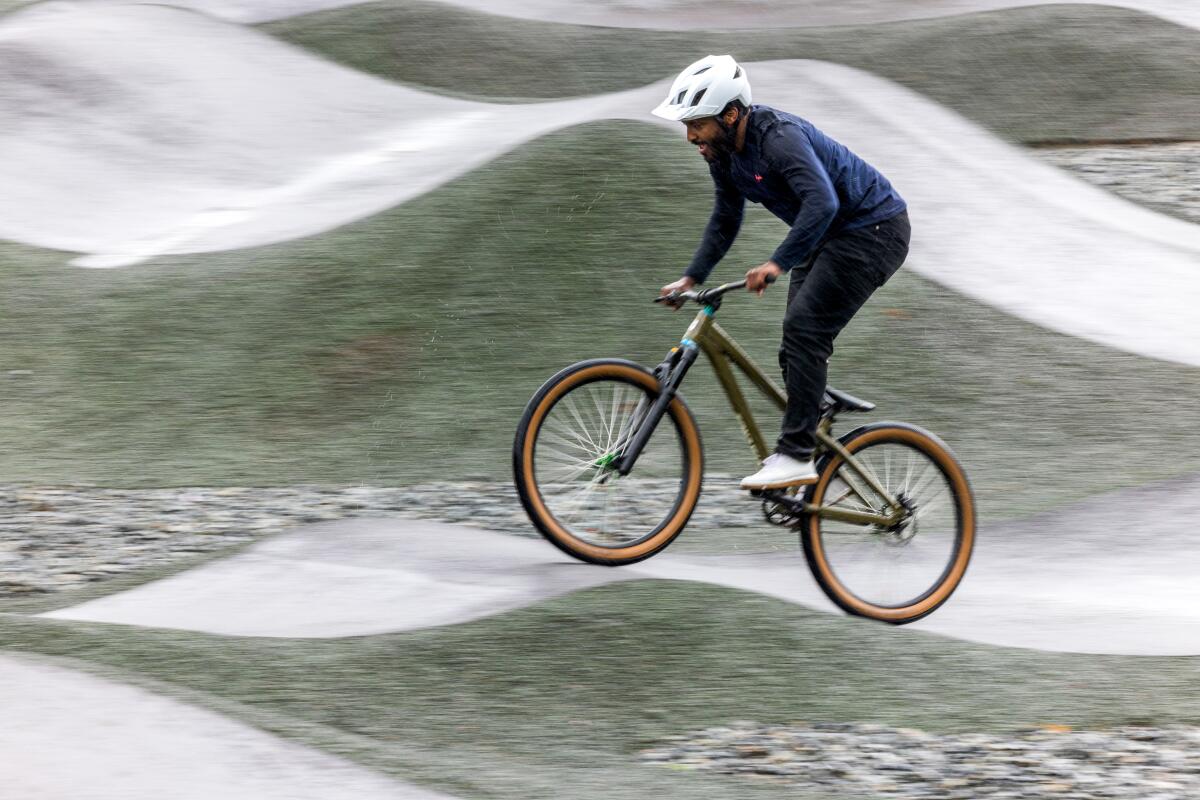
Eliot Jackson, a pro mountain biker, showcases his skills at the Inglewood Pumptrack.
(Alisha Jucevic / For The Times)
Jackson also hoped to help remedy the lack of diversity within the professional biking industry by building the track. Throughout his decade-plus long career, he was often the only Black person — or person of color — at the starting line at competitions. In August, after he retired from World Cup competition, Jackson launched the Grow Cycling Foundation, which is dedicated to making cycling more inclusive.
“I just thought about my life and all of the serendipitous things that led up to that,” says Jackson. Like his family “happening to move to California, where there’s mountains [and] my friend happening to take me up to Whistler Mountain Bike Park and introduce me [to downhill].”
“You start to think about the lack of opportunities that exist there, and I said, ‘What can I do?’” adds Jackson, who’s the chief executive of Grow Cycling, as well as a mountain bike expert for Red Bull.
The Inglewood Pumptrack, which cost $1.2 million, was fully funded by the cycling community for the cycling community with more than $300,000 in donations from individuals. The rest came from founding partners, including such brands as Yeti Cycles, Ride Fox, Pinkbike, Santa Cruz Bicycles, the Rapha Foundation and Adidas, Jackson says. (Jackson is also an ambassador for Santa Cruz Bicycles, Rapha and Fox.)
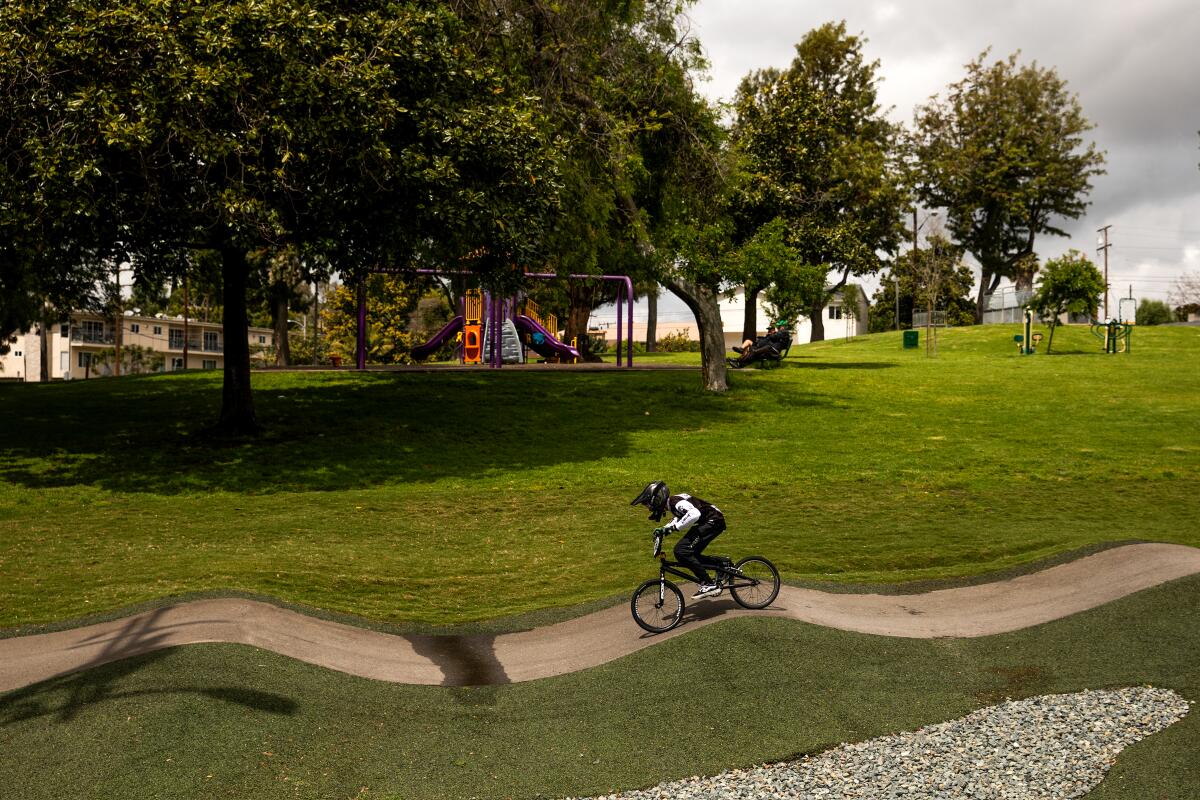
Jin Morita, 13, rides on the World Championship Track, one of two tracks at Inglewood Pumptrack at Edward Vincent Jr. Park in Inglewood.
(Alisha Jucevic / For The Times)
Constructed by Velosolutions, the site features two asphalt courses: The Woodlands and World Championship tracks. Woodlands, which is smaller and surrounds a host of trees, has smaller rollers and is designed for slower speeds. Whereas the colossus World Championship track, which is wider with large rollers, was built in a mirrored design so two riders can race in opposite directions at the same time. The design and name for this track was intentional as Jackson plans to host world championship competitions there. (Between both tracks, roughly 300 to 400 people were riding at the same time on opening day.) Both tracks are open to all ages and levels.
The Inglewood Pumptrack was specifically built with bicyclists in mind; for years, they were pushed out of skate parks and weren’t welcomed by the skateboarding community, says Joi Jackson, Eliot’s mom and the president of Grow Cycling.
They wanted to set a more inclusive precedent for bike infrastructure, so there are bike priority days at the track. Other wheels such as skateboards, longboards and rollerblades are welcome on specific days of the week. (A sign near the track entrance includes more details on this and other rules for the track.)
People who use wheelchairs or adaptive bikes can also utilize the track. However, no scooters or motorized vehicles such as e-bikes, hoverboards or electric scooters are allowed.
Ameri de Vera, 9, who rides BMX on a factory team for a company called Answer BMX, goes to the Inglewood Pumptrack at least twice a month with her older sister.
“I was scared at first because you have to get used to how it sways,” says De Vera, who was preparing for the BMX world championships on a recent Sunday. “It sways in different directions and there’s some sharp turns too. So you have to keep your eye on those, but it was really fun once I got used to it. And you can ride your skateboard on it.”

Eliot Jackson rides the Inglewood Pumptrack with BMX athletes, Ameri de Vera, 9, left, and her sister Vida de Vera, 11, center.
(Alisha Jucevic / For The Times)
For first-timers, she recommends gearing up and wearing a helmet for safety “because the first time, you’re probably going to fall.” She also encourages people to be aware of their surroundings and pay attention to what others are doing to avoid accidents.
Although there’s a skate ramp at the park, Erik Barnes, 50, says he prefers to ride on the pump track.
“There’s a proliferation of skate parks here, but none like this,” says Barnes of West Adams, who’s been an avid skateboarder since he was a teen. He sometimes brings his teenage son to the track with him.
“I meet a lot of guys my age or us older skaters who are just falling in love with this place. Everyone’s like, ‘It’s reignited skateboarding for me. It got me back into it,’ and that’s definitely the case for me.” Barnes frequents the track at least twice a week, usually before work.
What Barnes loves most about the track is that “you don’t have to be really good to enjoy this park.”
“You can kind of get yourself into a really fun zone of just cruising, which is a really pleasurable, fun thing to do,” he says. “It’s not exceedingly difficult.”
He adds, “You can just get into a nice flow. It’s rhythmic. It’s meditative and it’s a really good workout because you’re basically just doing squats the whole entire time.”
After not seeing many rollerskaters at the Inglewood Pumptrack each time they visited, Bily Ruiz, 26, started a weekly meetup called K.h.a.o.t.i.c Quads. The group, whose members range in age from 1 to 50, meet there on Sunday mornings.
“I love the community that [the track] is creating, because at some parks, the culture can be very standoffish or they don’t really talk to each other,” says Ruiz. Whereas at the Inglewood Pumptrack, “since everyone’s so excited, everyone’s like ‘What’s up? Hi. I see you. Good job.’”
“I look forward to it every weekend,” Ruiz says about about the group. “It’s so exciting, and every time we meet up, it fills me up with so much energy.”

“We built something that people love and that makes me the most happy,” says Eliot Jackson.
(Alisha Jucevic / For The Times)
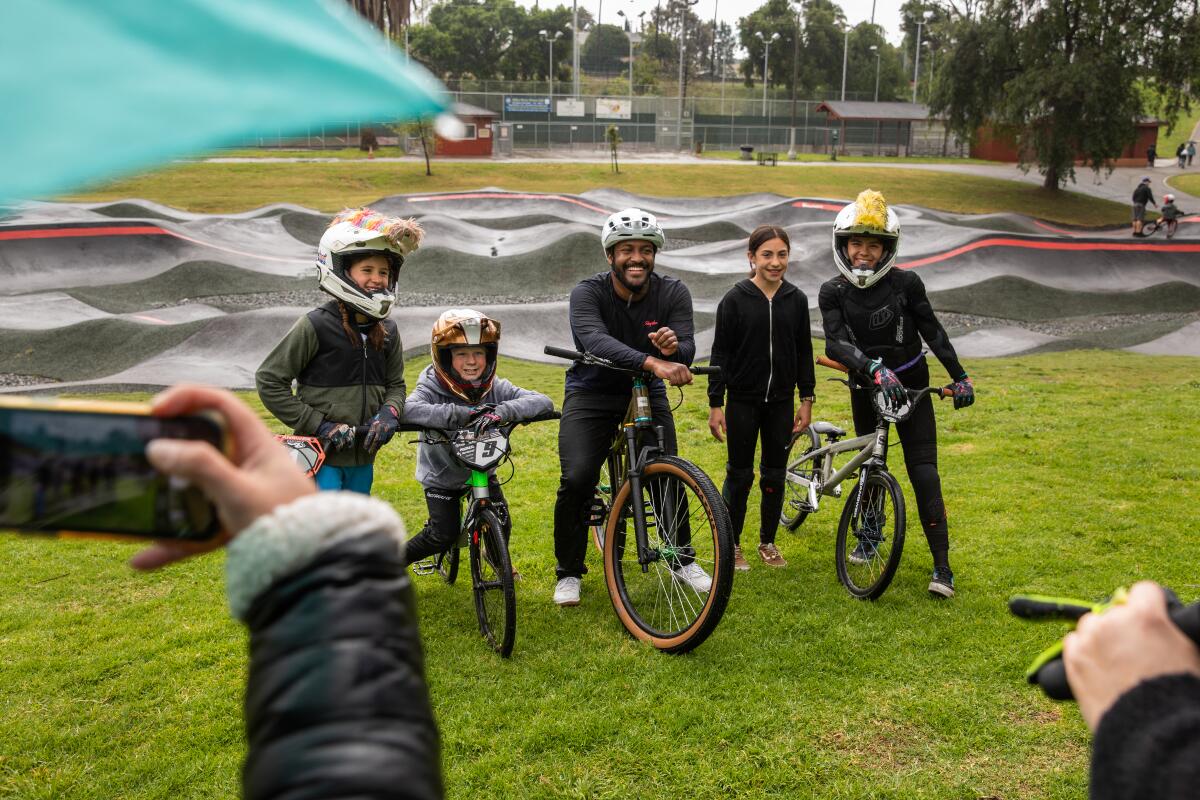
The parents of young BMX athletes take a photo of them with Eliot Jackson, center, at the Inglewood Pumptrack.
(Alisha Jucevic / For The Times)
The Grow Cycling Foundation has also donated permanent bike fleets to nearby in Inglewood elementary and middle schools , which they use for education programs. The organization views the pump track as the first step in a long-term mission to make cycling culturally relevant in the city.
In the meantime, though, Jackson says he’s enjoyed seeing kids who may have never seen or heard of a pump track before get to experience one for the first time — or simply fall back in love with riding bikes.
“We built something that people love and that makes me the most happy,” he says. “I just think about us as a family when we were growing up and my mom would’ve taken us every single day, and look at where I am now?
“And that will happen. There will be a kid who goes on to be better than I ever could because they got to discover a bicycle at this place.”
Lifestyle
Ryan Gosling is 'The Fall Guy' in this cheerfully nonsensical stuntman thriller

Ryan Gosling is Colt Seavers in The Fall Guy.
Universal Pictures
hide caption
toggle caption
Universal Pictures

Ryan Gosling is Colt Seavers in The Fall Guy.
Universal Pictures
From the 1933 action film Lucky Devils to the 1980 comedy-thriller The Stunt Man to Quentin Tarantino’s Once Upon a Time … in Hollywood, filmmakers have long delighted in turning the camera on stunt performers, those professional daredevils who risk life and limb to make action scenes look convincing.
It’s a hard, often thankless job, which is why for years people have lobbied the motion picture academy to present an Oscar for stunt work. And of course, it’s a dangerous job: Just last month, while shooting the Eddie Murphy movie The Pickup, several crew members were injured during a stunt involving two rolling cars.
There’s a lot of vehicular mayhem in the noisily diverting new action-comedy The Fall Guy, a feature-length reboot of the ’80s TV series. Ryan Gosling stars as a highly skilled stunt performer named Colt Seavers, who, despite his cynical film-noir-style voiceover, genuinely loves his job.
Colt loves movies and moviemaking, loves hurling himself off balconies and strapping himself into soon-to-be-totaled automobiles. Most of all, he loves Jody Moreno, an up-and-coming assistant director played by Emily Blunt, and she loves him right back.

Ryan Gosling and Emily Blunt star in The Fall Guy.
Universal Pictures
hide caption
toggle caption
Universal Pictures

Ryan Gosling and Emily Blunt star in The Fall Guy.
Universal Pictures
Colt works mainly as a stunt double for Tom Ryder, a world-famous movie star played by a preening Aaron Taylor-Johnson. But when Colt suffers a life-threatening injury on the set, he quits the biz in despair and ghosts Jody for more than a year while he recovers. But then he learns that Jody is directing a big-budget sci-fi movie in Sydney and wants him to be Tom’s stunt double again. Upon arriving Down Under, however, Colt finds out that Jody did not ask for him and has no idea why he’s here.
The reason for Colt’s appearance on the set is one mystery in a cheerfully nonsensical thriller plot devised by the screenwriter Drew Pearce. There’s also a body in a bathtub, an incriminating cell phone and several amusing side characters, including a busybody producer played by Hannah Waddingham of Ted Lasso fame.

Another key player is Colt’s best friend and stunt coordinator, Dan, played by the always excellent Winston Duke. In one endearing running gag, Colt and Dan keep quoting dialogue from classic films like The Last of the Mohicans, The Fugitive and The Lord of the Rings trilogy, all of which The Fall Guy giddily tries to outdo in its sheer volume of death-defying mayhem.
Before long, Colt isn’t just performing stunts. He’s forced to put his well-honed survival skills to good use off the set, whether he’s beating up thugs in a nightclub, punching villains in a helicopter or getting tossed around in the back of a speeding garbage truck. That’s one of several set-pieces that the director David Leitch opted to shoot using practical techniques, rather than CGI — a decision that gives this stunt-centric movie an undeniable integrity.

The Fall Guy is undoubtedly a passion project for Leitch, who once worked as a stunt double for actors including Brad Pitt and Jean-Claude Van Damme. (He nods to this by giving Colt a handy canine companion named Jean-Claude.) Leitch can direct action beautifully, as he did in the Charlize Theron smash-’em-up Atomic Blonde. But he can also go too flamboyantly over-the-top, as in sloppier recent efforts like Bullet Train and Hobbs & Shaw. The Fall Guy is better than those two, but it would have been better still with cleaner action, tighter editing and a running time south of two hours.

Blunt is such a good comedian and action star that it’s a shame she doesn’t get more to do in either department; Jody may be in the director’s chair, but as a character, she’s mainly a second banana. The Fall Guy is Gosling’s picture. Unlike the brooding, taciturn stuntmen the actor played in Drive and The Place Beyond the Pines, Colt is a wonderfully expressive goofball. There’s a moment here, after a fiery boat chase around Sydney Harbour, when Colt emerges triumphant from the water, clothes dripping and muscles bulging, while a euphoric cover of Kiss’ “I Was Made for Lovin’ You” surges for the umpteenth time on the soundtrack. It’s ridiculous and gloriously overwrought — and like the best-executed stunts, it comes perilously close to movie magic.
-

 News1 week ago
News1 week agoLarry Webb’s deathbed confession solves 2000 cold case murder of Susan and Natasha Carter, 10, whose remains were found hours after he died
-

 World1 week ago
World1 week agoHaiti Prime Minister Ariel Henry resigns, transitional council takes power
-

 News1 week ago
News1 week agoFirst cargo ship passes through new channel since Baltimore bridge collapse
-

 World1 week ago
World1 week agoUS secretly sent long-range ATACMS weapons to Ukraine
-

 World1 week ago
World1 week agoSpanish PM Pedro Sanchez suspends public duties to 'reflect'
-

 News1 week ago
News1 week agoAmerican Airlines passenger alleges discrimination over use of first-class restroom
-

 Movie Reviews1 week ago
Movie Reviews1 week agoHumane (2024) – Movie Review
-

 Education1 week ago
Education1 week agoVideo: Johnson Condemns Pro-Palestinian Protests at Columbia University


